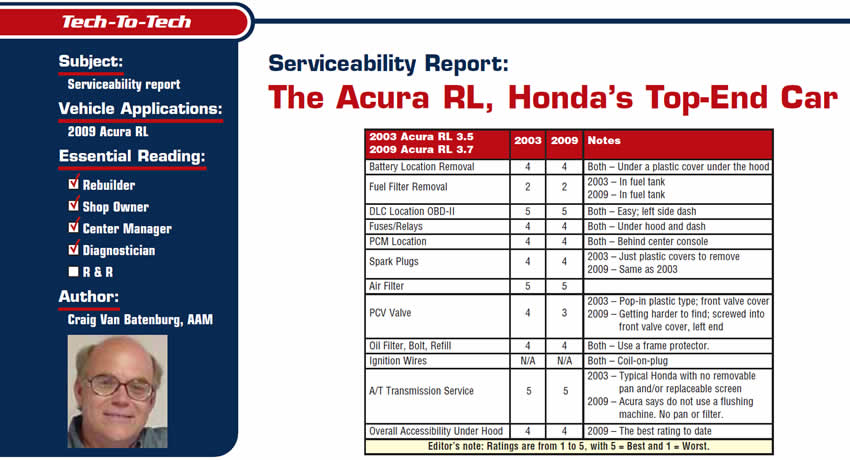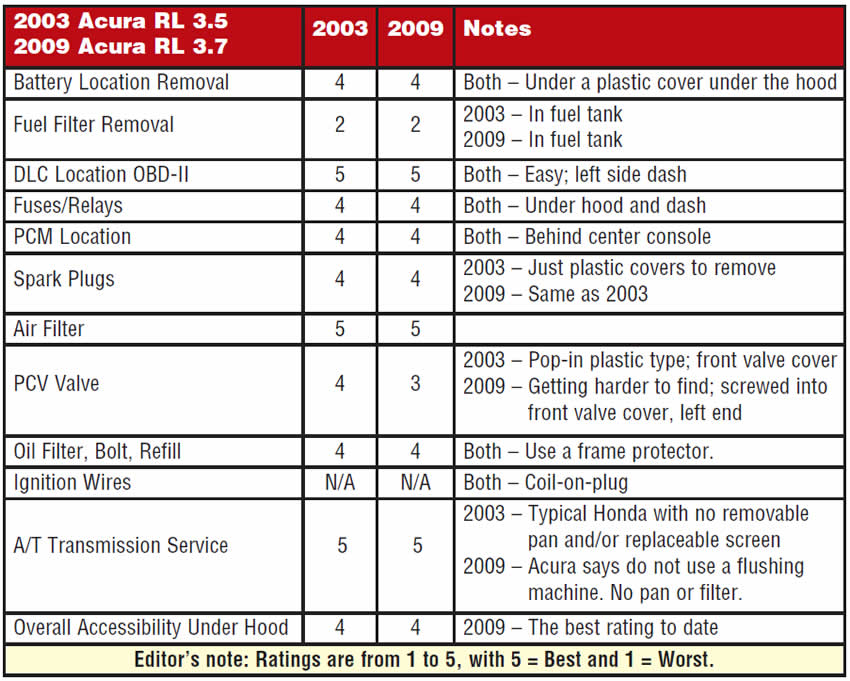
Tech to Tech
- Subject: Serviceability report
- Vehicle Application: 2009 Acura RL
- Essential Reading: Shop Owner, Center Manager, Rebuilder, Diagnostician
- Author: Craig Van Batenburg, AAM
How does the 2009 Acura RL compare with the 2003 Acura RL in terms of serviceability?
It has been six years ago this month since I was asked to speak for you in AutoInc. The purpose of my quarterly article is to have a dialogue in terms of a technician’s point of view when it comes to the design of cars and trucks.
All the top car and truck companies in the United States are experiencing a downturn in sales this year except one: Honda. Acura is a made-up name for a more-upscale Honda. What does American Honda Motor Co. Inc. do that makes it unique? Is Honda on your side? I asked Mike Spangler, service manager and a former technician at Piazza Acura in Ardmore, Pa., what he thought of the new Acura RL compared to an RL of years ago. Along with the help of the good people at Piazza Acura and my own research, here is what I found:
The Acura brand was launched in the fall of 1985. It was a big step for a small company. The Acura Legend was the flagship. For just under $20,000, you could buy – for the first time – a six-cylinder automobile from Honda. What happened along the way with the Legend that is the RL today? It is still a V-6, four-door sedan with high-tech features. On the downside, sales are off and have been for some time, the price has more than doubled and the RL is not as popular as the original.
What about serviceability? Let’s compare a 2003 RL with the new 2009 model. Anytime you add a V configuration, access to spark plugs, injectors and other parts can become more difficult.

The old Legend was renamed the “RL,” which Honda says stands for “Road Luxury,” in 1996. Not only were the first RLs’ major dimensions unchanged from the Legend – save for being 1 inch taller – but the basic suspension and engine designs and a total of 40% of its parts were Legend carryover. Some problems were also carried over, including a commonly occurring code: the P0401. This exhaust-gas-recirculation (EGR) problem code was the norm on the 1996-to-2004 3.5-liter Acuras – because, as any experienced tech can tell you, they are all too familiar. Starting with the very first 1986 Acura Legend, main relays would intermittently fail. Heat buildup under the dash was the most-likely cause, but this problem went on for more than a decade. Poor electrical connections also made for more than a few visits to the shop.
According to Identifix, the Vehicle Stability Assist (VSA) system has prompted a lot of calls to its tech line. There is a scan-tool software issue that will set a code 98 in the VSA system. Once the code is set it is hard to clear. Identifix has come up with a good solution. To clear the code, disconnect the scan tool and follow these steps:
- Keep your foot off the brake pedal and depress the parking-brake pedal.
- Press and hold the “VSA off” button at the same time and turn the ignition switch to on.
- Hold the VSA off switch until the system beeps four times and then release the switch.
- Watch the VSA light for more than three seconds. If the indicator comes on and blinks six times, the code is cleared.
As with any model, it is the tricks and vehicle-specific information that can make all the difference. One proven way to fix poor electrical connections is the application of Stabilant 22a, a conductivity enhancer. One drop will ensure an electrical connection that will transfer electrons with ease. Standard Motor Products lists this as SL-5 in its catalog. Technical Service Bulletin No. 06-50 allows a slightly longer warranty because of a 5% error in the odometer readings. This applies to many Acura models. One interesting note is that the 2003 RL had no recalls. Not bad for a high-tech car.
The 2009 RL
The RL was redesigned for the 2009 model year. The 2009 RL features an all-new powertrain consisting of a 3,700-cc (3.7-liter) V-6 front engine with 3.5mm bore, 3.7mm stroke, 11.2 compression ratio, overhead cam, variable valve timing/camshaft and four valves per cylinder, replacing the previous 3.5L V-6. The new 3.7L delivers more power, increased torque, a more-refined valve train and an overall package that is lighter than the V-6 it replaced. Rated at 300 horsepower, the new high-output 3.7L V-6 is as powerful as some V-8 engines. Compared with the old 3.5L V-6, the new 3.7L offers 9% more torque between idle and 3,000 rpm.
The 3.7L V-6 is teamed with a new Sequential SportShift 5-speed automatic transmission with revised shift parameters, a more-robust torque converter and two new forms of transmission-gear activation.
The 2009 RL comes standard with revised super-handling all-wheel drive (SH-AWD). This system is unique in the sense that it is the first all-wheel-drive system in the world to distribute the optimum amount of torque not only between the front and rear wheels but also between the left- and right-rear wheels. The system’s torque-vectoring direct yaw-control feature makes the cornering character of the RL exceptionally neutral under power. The system enhances steering by sending available rear power to the outside wheel and rotating it slightly faster than the front wheels, propelling the vehicle through the turn. When accelerating through a hard corner, up to 50% can be directed to the rear wheels – all of which can be directed to the outside wheel if needed. This feature is most remarkable.
As with many hybrids today, electric rack-and-pinion steering is used, along with Honda’s well-known racing-inspired double-wishbone front-suspension system, first used in 1983 on a Honda Prelude. You will see this car, priced around $50,000, in for service from time to time. Sales are not high, because Acura really needs to market its vehicles better. Acura is not thought of as being as prestigious as BMW, Lexus or Mercedes, even though the Acura is just as good if not better.
Servicing this car will require exactness, an upgraded scan tool and a mastery of electronics. Honda/Acura software in aftermarket scan tools is lacking. If you want to compete head-on with dealerships, then take a look at the factory scan tool. You can get a laptop-based unit, the GNA 600, which will keep your customers from going back to the dealership.
As with any car, once you get used to the layout and know how to operate a scan tool for that make, servicing it can be some of the better work you are asked to do. One passing thought: If your shop is in a city of more than 100,000 people, do you really need to be a generalist? Would it make sense to pick three of four brands and specialize? What if you told each customer as they came in over the next two years that you are going to service only cars X, Y and Z and ask them to choose one of those makes in the future (if they don’t have that make now). Would they do it so they could stay a customer of yours? And if they did, how would that affect your business? Think it over and expect to hear from me about that in the future. In the meantime, have patience with those poorly designed cars you see in your bay from time to time.

Craig Van Batenburg, AAM, is the owner of the Automotive Career Development Center (ACDC), www.auto-careers.org, and delivers management and technical seminars nationwide. He formerly owned Van Batenburg’s Garage Inc. in Worcester, Mass., for more than 25 years. Van Batenburg is ASE master and L1 certified, with advanced skills in hybrid drive systems. You can reach him by e-mail at [email protected].













